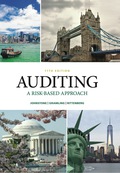
EBK AUDITING: A RISK BASED-APPROACH
11th Edition
ISBN: 9781337670203
Author: RITTENBERG
Publisher: YUZU
expand_more
expand_more
format_list_bulleted
Question
Chapter 7, Problem 10CYBK
To determine
Introduction: Sufficiency means the quantity of Audit evidence while Appropriateness is the quality of audit evidence. Audit evidence may be collected from Internal documents of the organization as well from External sources also.
To Explain:Whether the given statement is true or false.
Expert Solution & Answer
Want to see the full answer?
Check out a sample textbook solution
Students have asked these similar questions
Can you solve this general accounting problem using accurate calculation methods?
What would be his recognize gain ?
Lynn Inc has provided the following data from its activity-based system
Chapter 7 Solutions
EBK AUDITING: A RISK BASED-APPROACH
Ch. 7 - Prob. 1CYBKCh. 7 - Prob. 2CYBKCh. 7 - Prob. 3CYBKCh. 7 - Prob. 4CYBKCh. 7 - Prob. 5CYBKCh. 7 - Prob. 6CYBKCh. 7 - Prob. 7CYBKCh. 7 - Prob. 8CYBKCh. 7 - Prob. 9CYBKCh. 7 - Prob. 10CYBK
Ch. 7 - Prob. 11CYBKCh. 7 - Prob. 12CYBKCh. 7 - Prob. 1RQSCCh. 7 - Prob. 2RQSCCh. 7 - Prob. 3RQSCCh. 7 - Prob. 4RQSCCh. 7 - Prob. 7RQSCCh. 7 - Prob. 8RQSCCh. 7 - How does inherent risk relate to internal...Ch. 7 - Prob. 10RQSCCh. 7 - Prob. 11RQSCCh. 7 - Prob. 12RQSCCh. 7 - Prob. 13RQSCCh. 7 - Prob. 14RQSCCh. 7 - Prob. 15RQSCCh. 7 - Prob. 17RQSCCh. 7 - Prob. 18RQSCCh. 7 - Prob. 19RQSCCh. 7 - Prob. 22RQSCCh. 7 - Prob. 23RQSCCh. 7 - Prob. 24RQSCCh. 7 - Prob. 25RQSCCh. 7 - Prob. 26RQSCCh. 7 - Prob. 27RQSCCh. 7 - Prob. 29FF
Knowledge Booster
Similar questions
- The GNR Manufacturing Co. recorded overhead costs of $21,500 at an activity level of 5,000 machine hours and $8,000 at 2,500 machine hours. The records also indicated that overhead of $10,000 was incurred at 4,200 machine hours. Using the high-low method to estimate the cost equation, determine the variable cost per machine hour.arrow_forwardNeed help this question solution pleasearrow_forwardI need help finding the accurate solution to this general accounting problem with valid methods.arrow_forward
- Can you solve this general accounting problem with appropriate steps and explanations?arrow_forwardCan you explain this general accounting question using accurate calculation methods?arrow_forwardI am trying to find the accurate solution to this financial accounting problem with appropriate explanations.arrow_forward
arrow_back_ios
SEE MORE QUESTIONS
arrow_forward_ios
Recommended textbooks for you
 Auditing: A Risk Based-Approach (MindTap Course L...AccountingISBN:9781337619455Author:Karla M Johnstone, Audrey A. Gramling, Larry E. RittenbergPublisher:Cengage Learning
Auditing: A Risk Based-Approach (MindTap Course L...AccountingISBN:9781337619455Author:Karla M Johnstone, Audrey A. Gramling, Larry E. RittenbergPublisher:Cengage Learning Auditing: A Risk Based-Approach to Conducting a Q...AccountingISBN:9781305080577Author:Karla M Johnstone, Audrey A. Gramling, Larry E. RittenbergPublisher:South-Western College Pub
Auditing: A Risk Based-Approach to Conducting a Q...AccountingISBN:9781305080577Author:Karla M Johnstone, Audrey A. Gramling, Larry E. RittenbergPublisher:South-Western College Pub

Auditing: A Risk Based-Approach (MindTap Course L...
Accounting
ISBN:9781337619455
Author:Karla M Johnstone, Audrey A. Gramling, Larry E. Rittenberg
Publisher:Cengage Learning

Auditing: A Risk Based-Approach to Conducting a Q...
Accounting
ISBN:9781305080577
Author:Karla M Johnstone, Audrey A. Gramling, Larry E. Rittenberg
Publisher:South-Western College Pub